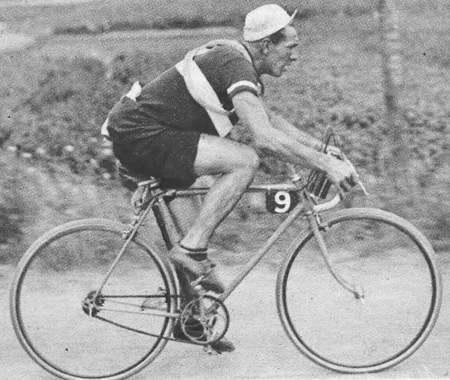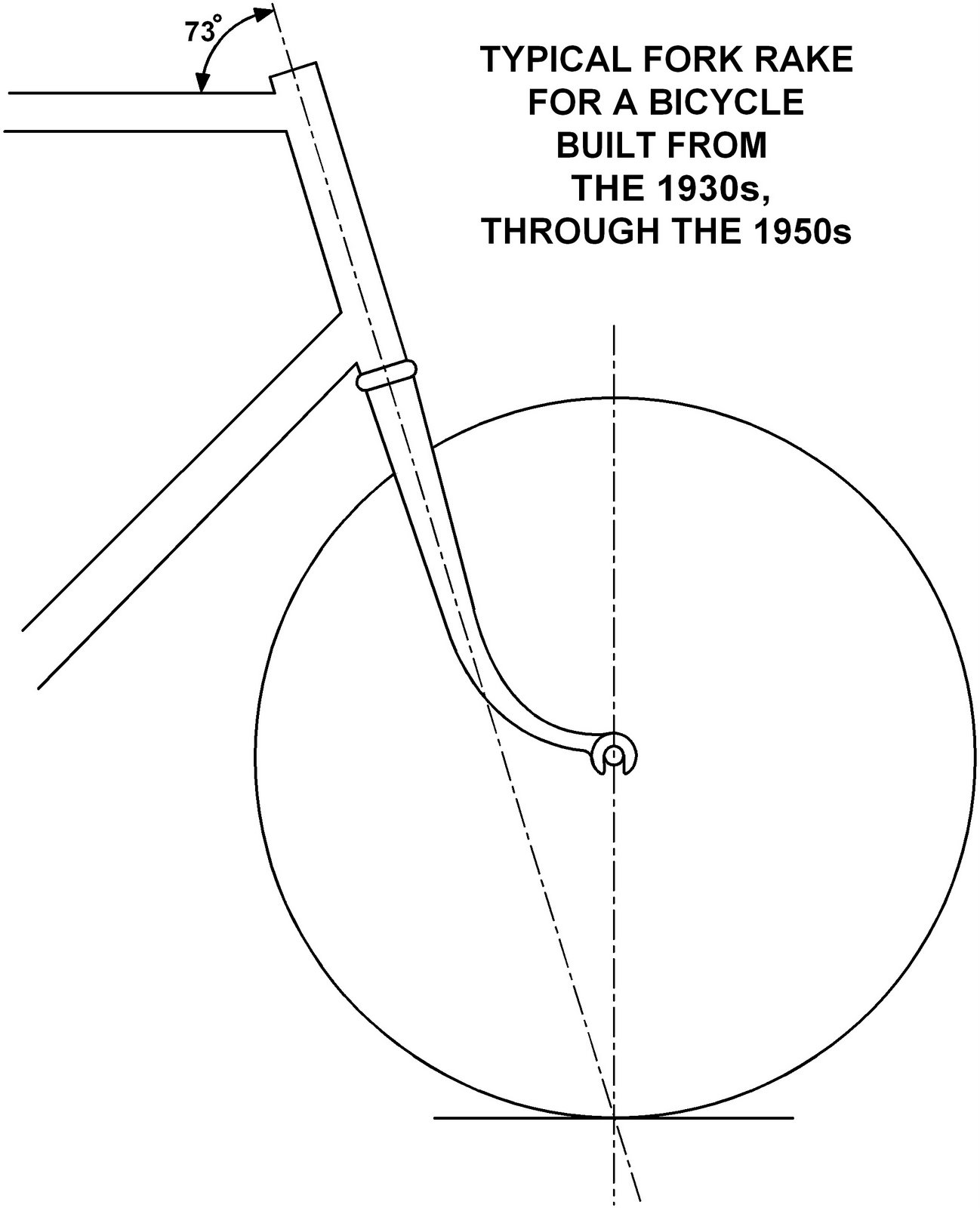The New Normal
 Mon, January 22, 2018
Mon, January 22, 2018  Italian cyclist Giuseppe Martano. 1934 TDF
Italian cyclist Giuseppe Martano. 1934 TDF
Life is a constant change, new ideas, and new technology. People hate change, they fight against it, but it is futile. Change will come for better or worse. In time we accept change, (Often we have no choice.) and a new “Normal” is established.
In the mid-1970s I wrote a series of articles on frame design for the British “Cycling” magazine. There was no Internet back then, no email, and no comments section where you could debate any ideas put forward. However, one older gentleman took the trouble to write and mail me a long hand-written letter, explaining my theories on “Trail” were wrong, and he enclosed a photocopy of an article from ‘Cycling’ dated 1946 to prove it.
 Back in the 1930s, 1940s, and even into the 1950s, there was a thinking that trail was a bad thing.
Back in the 1930s, 1940s, and even into the 1950s, there was a thinking that trail was a bad thing.
It was thought that it made the steering of the bike sluggish.
Front forks had a rake (Offset.) of 3 to 3.5 inches. (76mm. to 90mm.) See the photo at the top, from the 1934 Tour de F rance, and the drawing, left.
I can even see where this idea gained traction.
At first glance it seems logical that the steering axis should reach the ground at the exact point the wheel makes contact and therefore turns at that point. Or it would make sense if a cyclist steered his bike by turning the handlebars, and the frame remained upright.
However, we steer a bicycle by leaning in the direction we wish to turn, and the steering axis ahead of the wheel’s point of contact, is one of the forces causing the wheel to turn in the direction of the lean. (See drawing below right.)
As far back as the late 1950s, early 1960s, I had realized that trail was a good thing, as had almost every other framebuilder. It provides a caster action, and gives the bike stability when going straight, and certain ‘self-steering’ characteristics into the corners.
 Trail is the distance the wheel "Trails" behind the steering axis
Trail is the distance the wheel "Trails" behind the steering axis
However, trail goes hand in hand with the head angle. Steeper angles are more sensitive, and need less trail to achieve the same self-steering qualities. As many framebuilders in the 1970s were building frames with 75 and even 76 degree head angles, their trail would have been a lot less than mine.
Also, as my seat angles were steeper the rider’s weight was more forward, which also affected the ‘feel’ of the steering. The point I am making, you cannot simply say fork rake should be this much, and trail should be this, without taking into account the whole frame’s geometry.
My last article, where I explained the thinking behind my design philosophy, and the comments that followed, reminded me of the old gentleman that took the time to write me in the mid-1970s. He was quoting from an article written 30 years earlier in the mid-1940s.
It made me realize there were more changes made in the 30 years that were the 60s, 70s, and 80s. than there were in the previous 60 or more years. Changes in actual frame geometry that is. Angles, tube lengths, and fork offset, etc. Closer wheel clearances, shorter wheelbases, and higher bottom brackets too.
Some changes brought about by economic factors, others by framebuilders trying the make something better. It once again made me realize how fortunate I was to have been around in that period. Those times will never happen again. There was so much experimentation going on amongst so many individual craftsmen. There will never be that many individual craftsmen at the same time again.
We have also seen many changes in the last 30 or more years since the 1980s. The whole appearance of the bicycle has changed. We’ve seen clipless pedals, index shifting, leading to 11 gears. Thread-less headsets. Oversize tubes and carbon fiber have changed to look of the frame, along with sloping top tubes and tee-shirt sizing.
But actual frame geometry has not changed that much, 73/73 angles came out in the 1960s. My road bike fork rake was 35mm. I don’t think other steel framebuilders were too far away from that. Probably around 38mm. was an average. It seems to me fork rakes increased when carbon forks became the norm. But you will have to ask others in the know to confirm that.




















Reader Comments (12)
Jan Heine sits in the corner opposite you, calling for a return to pretty much all things French cyclotouring bikes, including low trail geometry.
His Bicycle Quarterly has lots of data and ways to interpret it, but I do think It's self evident that trail is a function of rake and tire. Some say the bigger contact patch of fatter, lower pressure rubber imparts its own stability, but I wonder if that's anything more than pushing even farther back from the axle (in a sense).
Unfortunately for consumers, perhaps less for the producers, the knowability of questions like these is at odds with their profitability.
Well, it gets interesting, an opposing view right off the bat. With my tongue placed firmly in my cheek, I can say there is an article I wrote 40 years ago to prove that wrong. But please, let's not compare racing bikes with touring bikes, they are somewhat different animals.
Seriously though, it is a fact that bikes I built went round corners very well. As most people riding them today are running wider tires, How do they ride with the fat tires, better, worse, about the same?
Before we get into an argument about what is best, please help me out, let's hear from people who actually ride the product I produced.
Dave
I have no experience racing or riding a Moulton bicycle. My experience is limited to light touring and club rides.
I purchased a 650B bicycle and equipped it with 38 mm tires. The trail was around 68 mm. The bike was unstable at low speeds, was susceptible to veering off course in gusty winds and didn't handle well with a small handlebar bag. A new fork with more offset resulting in about 35 mm of trail solved all the above problems.
I don't think the bike handles as quickly as a classic race type, but since I don't ride in groups it doesn't matter to me. I find the extra stability is especially helpful at the end of a long day.
Dave: I don't want an argument, I just wanted you to know that the debate rages on. The old thinking still has disciples, they are gaining in number, and few if any are as influential as Heine. You can spend the whole day reading his takes, both objective and anecdotal, about geometry, tires, handling, components, etc. and if I disagree with some, I enjoy reading them all.
Overseas production has been the death of experimentation. Big builders risk a lot of capital on shipping containers full of bikes. A year later, when they finally arrive, they have to sell immediately or be deemed a failure. Small builders reduce that exposure, but they are inaccessible to the common man. This is not the kind of economy that lends itself to creativity.
Despite having a number of bikes, including some built by Dave, I'm such a pedestrian rider I really just take what I get to be honest. Certainly some bikes are more comfortable, and some more lively, but no bike that I own is too twitchy or relaxed as far as I can tell.
Now, I'm no racer. I've not ridden a bicycle no-hands for more than a few seconds at a time. Perhaps I just don't have the fine sense of balance. Possibly it's because I'm quite tall. It's not really important to me, but it may be some are more attuned.
I do find it interesting that even quite experienced motorcycle and bicycle riders will contradict me when I explain that to turn a two wheeler right, you actually push the handlebars to the left (push the right side away)
Champs,
I was joking, I appreciate you pointing out the opposing viewpoint, I just thought it funny it came so quickly.
SteveP,
You speak of "Counter Steer." I explained how that works here:
http://davesbikeblog.squarespace.com/blog/2007/4/9/head-angles-and-steering.html
Dave.
I'm curious; what is the picture of martano demonstrating -- 0 trail?
His body position looks strange to me, the right leg/knee very high, and of course his frame is very large and seatpost very short by today's standards.
RubeRad,
I think you answered your own question. It illustrates No trail, Low saddle, big frame, rider sitting very far back. This was still the standard race position 20 years later in the 1950s when I started racing. As a teenager I was told this is how it is because the "Old Timers" who had raced for years say so. It was so uncomfortable, especially when making maximum effort. As the years passed and I gained experience I began to question the old school thinking..
Dave
I seem to remember that in the early 80's, bikes with steep head angles (75 or 76) were usually recommended for Criterium racing, rather than road races (square 73/73 angles). For touring bikes, seat angle was often 72.
I just wanted to refer to your words:
"Those times will never happen again. There was so much experimentation going on amongst so many individual craftsmen."
I realize that you're talking about road bikes here but if you take a broader look, these words are not exactly true. Since the early 80's and the arrival of mountain bikes, the world of bicycles has been evolving incredibly quickly - I would say, much faster than in the 60's-70's.
Yes, the evolution of road bikes you're describing has stalled a bit, but mountain bikes are still evolving and it's happening fast. During the last 20 years nearly everything in mountain bikes has changed: chainstays length, head tube angles, top tubes, fork travel and rake, tire widths, etc. This is sometimes taken to extreme as shown by smaller builders such as German Nicolai:
https://www.bikeradar.com/mtb/gear/category/bikes/mountain-bikes/full-suspension/product/review-mojo-nicolai-geometron-50373/
http://www.bikeradar.com/blog/article/interview-chris-porter-on-his-custom-nicolai-ion-16-41053/
In terms of geometry, tire choices and drivetrains we now have more options than ever and this evolution will continue. This makes me think that the most interesting time in the entire world of bicycles (not just road bikes) is happening now.
And between Guiseppe Martano's back tyre and the seat tube is room for a pump.
If you like to ride fast and race, go right ahead.
That is not the type of bike I prefer, so therefor it isn't better design.
For me. I'll take a chopper built from a trash-picked bike and enjoy that ride too.
People fight against change and do not stop it, but often they direct change.